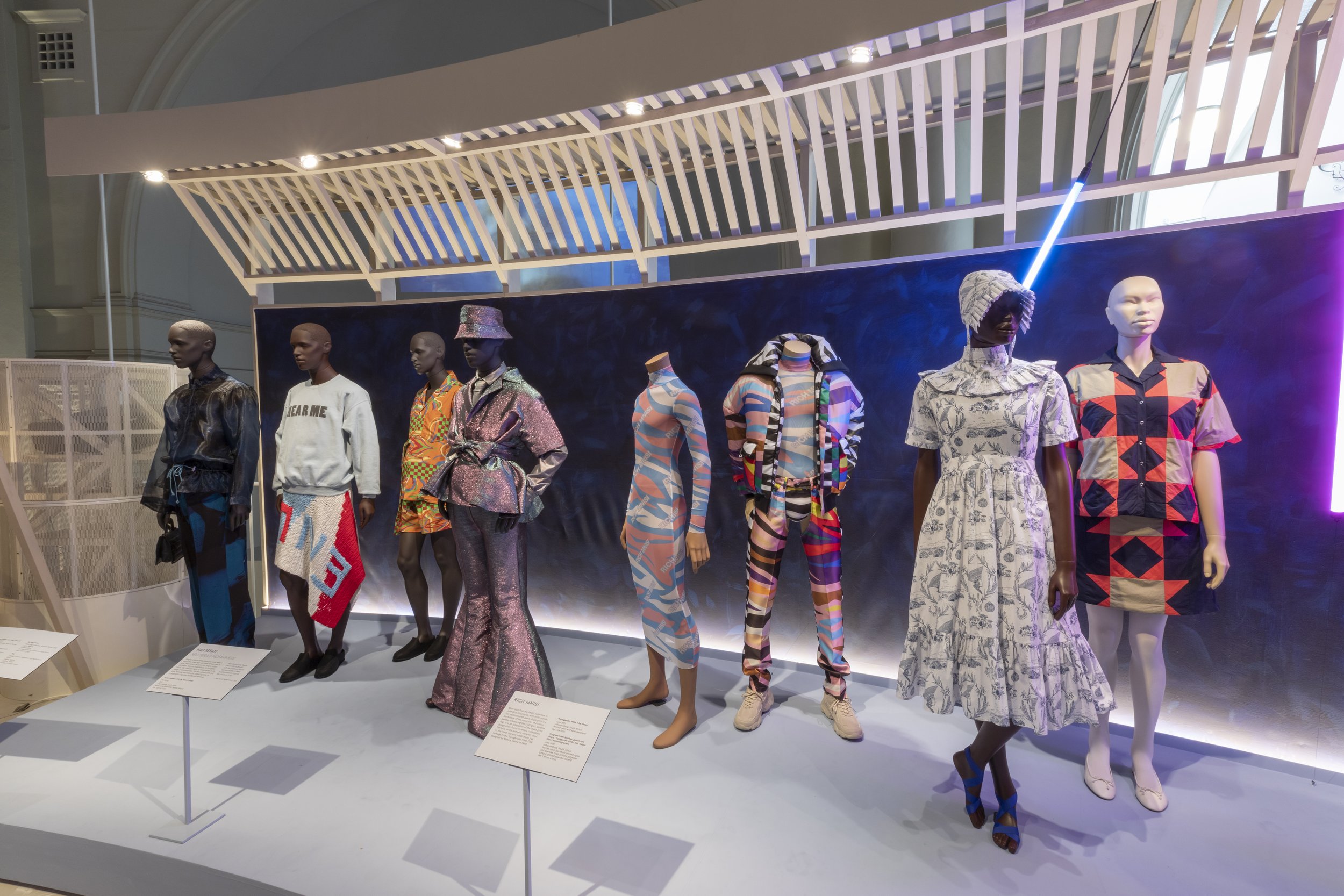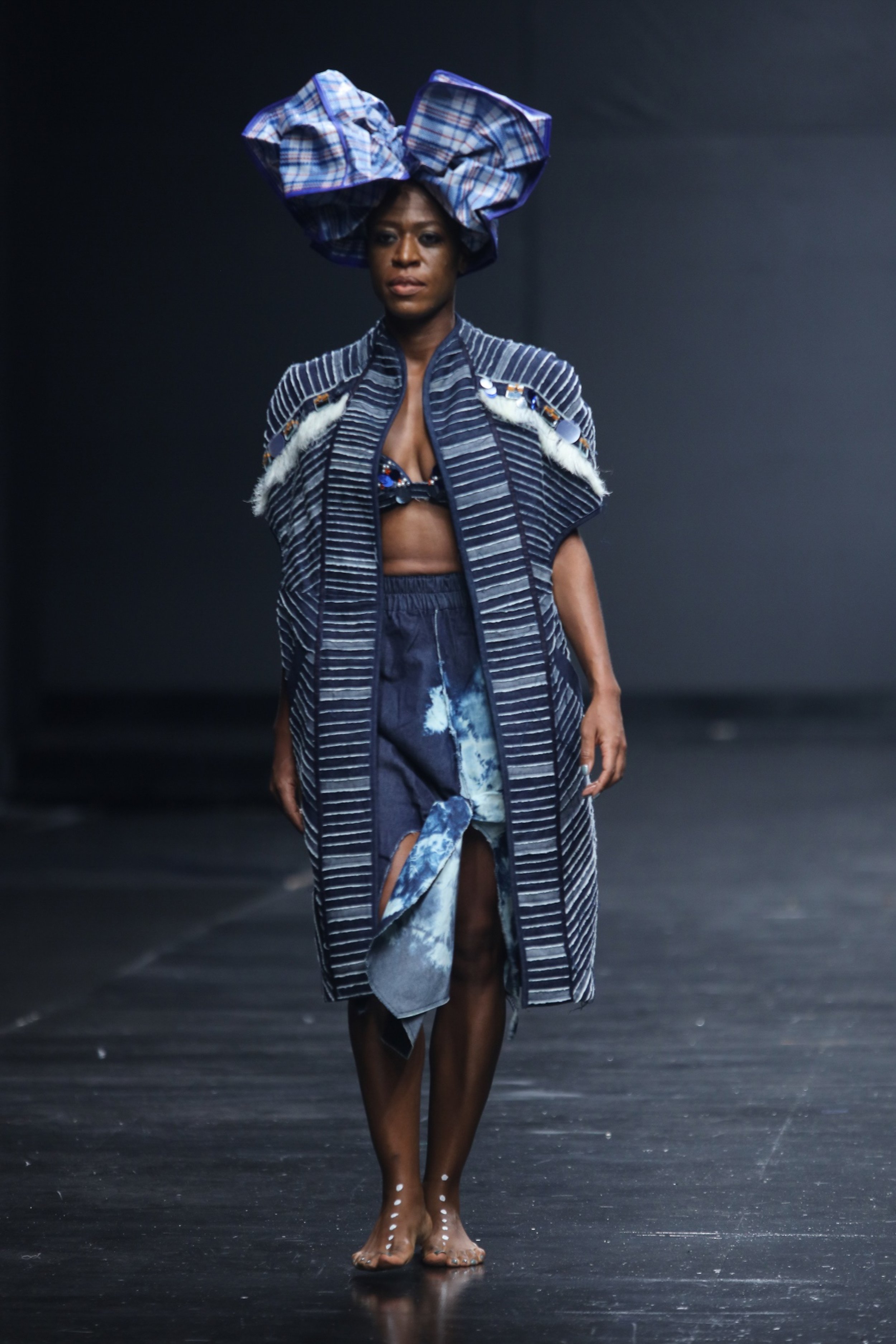How the V&A takes on colonialism one (or three) exhibition at a time
V&A is more than a museum. It was created in the 1850s to showcase achievement in art and design – to instruct the British manufacturers and public in what was good (and briefly in what wasn’t). The exhibits came from all over the world and in all materials and techniques. It is surprising then that the current show Africa Fashion is the first to showcase design from that continent in the museum. But then the V&A is currently experiencing some sort of transformation – not only physically, but ethically.
What is Seen and What is Not, Osman Yousefzada, Victoria and Albert Museum (photo by Tim Whitby, Getty Images for V&A)
Many institutions have taken onboard the #MeToo and #BlackLivesMatter messages. Most have done something in reference to these, some more convincingly than others. But the V&A is doing a rethink big time. Its autumn exhibitions celebrate a woman artist and writer; wider gender fluidity; fashion from the African continent; popular culture from Asia – and that’s just the big shows. There are myriad temporary displays making statements on colonialism, migration and identity. It seems like all the boxes are ticked, but I sincerely hope it is more than that.
This is also the autumn when the Queen Elizabeth II died. Her portrait was displayed both physically at the entrance to the museum and virtually on the landing page of its website. The museum was shut for her funeral. Like the rest of the country, the V&A was in official mourning. But some voices in the UK and abroad have started asking questions – questions that have been hushed for some time, some say out of respect for the late Queen. These raise quite uncomfortable (for the establishment and its supporters) issues of Empire and colonialism and Britain’s relationship with its history. Britain in this case is personified by the monarch, even if it has been a ceremonial constitutional monarchy for well over a century.
The V&A has been ahead of the game in terms of its reckoning with the Imperial past. Not in terms of the main collection yet, but one temporary exhibition and two displays this autumn deal with the implications of the colonial legacy. The V&A has a history of exhibiting contemporary art alongside and in dialogue with its permanent collection and architectural spaces.
Osman Yousefzada, Danish Shalwani @Unikrew Production, V&A
Osman Yousefzada’s three site-specific works collectively named What Is Seen and What Is Not (2022) are an example of this. The first site was the main entrance hall – where three richly coloured tapestries hang like royal standards – floating in-between the beige and cream columns under the arch. In these works, Yousefzada, a British-Pakistani artist, takes inspiration from 16th and 17th century tarot cards prevalent in Iran, Turkey and Mughal India and renders them in large scale embroidered form made in Pakistan.
Dedicated to the 75th Anniversary of Pakistan these ‘interventions’, as the V&A calls them, are reflections on contemporary Pakistan through the eyes of a British-born member of a Pakistani diaspora. Inevitably questions of migration and belonging come into play. Pakistan and Britain share a colonial history – Queen Victoria was opening the V&A and waging colonial wars at about the same time. Even after its independence Pakistan remained a monarchy for a further 9 years – Queen Elizabeth II being its last monarch before it became a republic. As the artist points out the country is still very much a subject to neo-colonial structures – whereby “contributing less than 1% of green gas emissions … it is the 5th most vulnerable country to climate change.” This year’s floods which covered a third of the country are only a warning of what is yet to come.
What is Seen and What is Not, Osman Yousefzada, (c) V&A
This is a country that has seen mass migrations in its recent history. The second installation of the three at the V&A was a shelving unit in the sculpture gallery covered with wrapped parcels. Luggage has long been a metaphor for migration – whatever is taken, much more is always left behind. And once in the new home, if it ever become that, these parcels sometimes are left unopened. This is because life is so different in the new place, that what one thinks one will need is no longer relevant. Or, more tragically, because the family or individual never quite settles and remains forever prepared to return.
The third installation of the trilogy was in the John Madejeski Garden. Colourful mora stools and charpai daybeds stand haphazardly around this outside space. The public is encouraged to move and use them as they see fit. Handmade out of re-purposed doors and garment waste from factory floors – they also showcase different traditional weaving techniques. They are also about making something divisive and hierarchical, such as vertical doors, into something that is comforting and communal, like the horizontal daybeds in a public space.
Europe Supported by Africa and America, Sokari Douglas Camp, Victoria and Albert Museum (photo by the author)
Near to Yousefzada’s works is another temporary installation. Set among the sculptures of the permanent collection is a new take on The Three Graces. It is a work by Sokari Douglas Camp, a British-Nigerian artist, a jagged take on interrelated forms of power – colonialism, slavery, gender, climate change. Europe Supported by Africa and America (2015) is made of steel and petrol nozzles – both its title (taken from William Blake’s abolitionist print of 1796) and choice of material make the narrative clear – the relationships between these three continents have relied for centuries on exploitation of natural and human resources of some cultures for the benefit of others.
The work references directly two works in the V&A’s permanent collection. Highly sexualised Antonio Canova’s The Three Graces (1814-17) in shiny white marble is in the same room. While William Blake’s print calling for the abolition of slavery is in the archives. Douglas Camp’s version criticises both earlier ones by clothing all three women – removing the overt eroticism. This is further emphasised by the rough way in which the metal is treated, with purposedly obvious soldering and uneven edges everywhere. The uneasy references of Blake’s print – armlets to signify slavery – are removed in favour of skirts in fabrics that themselves point to colonial interchanges. African Kente cloth features on one, while another has Paisley print – itself of multicultural origin coming from Persia and India, via a Scottish town where it was produced.
Douglas Camp’s work accompanies a current Africa Fashion exhibition – standing opposite an entrance to it. I am a little uneasy about the notion that a whole continent’s creative production can be encompassed in one exhibition. Even a profile of one country is somewhat questionable – the Epic Iran exhibition was an example of a rather non-epic show for a much greater subject. Can you really fathom a show of, say, Europe Fashion or Asia Fashion? But everything must start somewhere. And if in British eyes Africa is one uniform whole – an exhibition about it may be a chance to explore just how much it isn’t.
Africa Fashion at the Victoria and Albert Museum, London, 2 July 2022 – 16 April 2023.
Forty five designers from twenty countries are gathered here, but there is an even more impressive statistic: half of the objects on display are in the permanent collection and more than half of those are new acquisitions. You will learn that a lot of the designers shown here are ‘iconic’ or ‘influential’ – yet it is the first time they are presented in a London museum.
This is really two exhibitions in one – a division accentuated by the architecture of the exhibition space. On the ground floor level is a show about independence movements and how fabric and fashion played their part in the resistance and renaissance of African culture. While the upper level is dedicated to contemporary fashion designers and photography.
Kofi Ansah 'Indigo' Couture 1997 - Narh & Linda - Photo © 1997 Eric Don- Arthur _ www.EricDonArthur.com _MG_8656-3. Africa Fashion at the Victoria and Albert Museum, London, 2 July 2022 – 16 April 2023.
The exhibition’s entry text ends with a gushing: ‘Every cut, line, drape and stitch, each fabric and fibre, reveals a tale of agency and abundance from myriad African perspectives.’ This vision of fashion, of any form of consumption, is very now – when every decision we make is tainted with the origin story. Eco-friendly, local, seasonal, inclusive, culturally sensitive etc, are just some ways in which the middle classes like to torture themselves, in absence of the real thing. These are outward identities that may or may not correspond to one’s actual beliefs, usually encouraged by society and frowned upon if not upheld. When it comes to cloth choice in pre-independence Ghana for example, it feels wholly on a different level. The identity is both within and without. It is something that has a long tradition, which can manifest and flourish without being repressed.
Kente cloths, while playing a significant part in the image of the independence movement in Ghana when worn by the first president Kwame Nkrumah (among others), are in fact ancient cloths. Different patterns reference occasions as varied as an historical event or a private celebration. They can be woven stories or markers of a milestone. Being hand-made, they are treasured and kept by family members – such as the one on display here, kept since 1963, originally made to commemorate the current owner’s birth.
MAXHOSA AFRICA, IAMISIGO, Imane Ayissi © Victoria and Albert Museum, London; Africa Fashion at the Victoria and Albert Museum, London, 2 July 2022 – 16 April 2023.
There is a great variety of cloths and their significances presented here. Some purposefully colourful and attention grabbing like printed ABC kaba designs. Others streamlined almost down to monochrome such as àdìre – an indigo resist-dyed cloth – which Nigerian designers have brought from its historic roots to contemporary fashion. Kofi Ansah – the so-called ‘enfant terrible’ of Ghanian fashion and a supporter of Pan-Africanism – made a tribute to àdìre in his Blue Zone collection which also featured robes with silhouettes similar to Japanese kimono. His son has quoted him saying: ‘West isn’t always best… Inspiration is all around you.’
The designers upstairs have certainly learned that lesson. Rich Mnisi in his PRIDE collection makes dresses and jackets in a zebra-stripe print in blue, white and pink – colours of the Transgender Pride Flag. For Imane Ayissi it is not only about colour – but about how a mixture of textures can signal luxury. In his white dress for Akouma collection, he sews together silk, hemp and the Cameroonian bark cloth obom. Nkwo Onwuka discovers the environmental side of traditional techniques, inventing a DAKALA cloth, which has the appearance of traditional woven cloth but is made of waste fabric.
DAKALA CLOTH ensemble, 'Who Knew' collection, Abuja, Nigeria, Spring/Summer 2019; Image courtesy Nkwo Onwuka © Kola Oshalusi; Africa Fashion at the Victoria and Albert Museum, London, 2 July 2022 – 16 April 2023.
When the weather turns rainy and the park is no longer the most enticing place in the world, you may end up in one of London’s many wonderful public museums, which are gradually becoming more representative of that public. The V&A is used to showing the best from around the world, but for a very long the world did not quite mean all humanity, redress is overdue, but is certainly still welcome.









